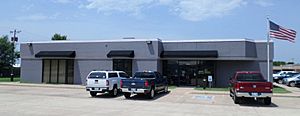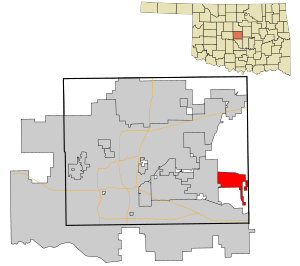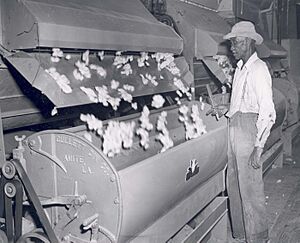Harrah, Oklahoma facts for kids
Quick facts for kids
Harrah, Oklahoma
|
|
|---|---|

Harrah City Hall
|
|
| Motto(s):
"Heart of the Heartland"
|
|

Location in Oklahoma County and the state of Oklahoma.
|
|
| Country | United States |
| State | Oklahoma |
| County | Oklahoma |
| Area | |
| • Total | 12.42 sq mi (32.16 km2) |
| • Land | 12.42 sq mi (32.16 km2) |
| • Water | 0.00 sq mi (0.00 km2) |
| Elevation | 1,139 ft (347 m) |
| Population
(2020)
|
|
| • Total | 6,245 |
| • Density | 502.98/sq mi (194.20/km2) |
| Time zone | UTC-6 (Central (CST)) |
| • Summer (DST) | UTC-5 (CDT) |
| ZIP code |
73045
|
| Area code(s) | 405 |
| FIPS code | 40-32750 |
| GNIS feature ID | 2410705 |
Harrah is a city in Oklahoma County, Oklahoma, in the United States. It's part of the larger Oklahoma City metropolitan area. Harrah is about 25 miles (40 km) east of downtown Oklahoma City. In 2020, about 6,245 people lived there. This was a 22.6% increase from 2010.
The first person to settle in the area was a Potawatomi person in the 1870s. The town officially became a city in 1908. People from America, Poland, and other places settled here. Harrah used to be a big center for processing cotton. A city council and a mayor lead the city. Harrah also has its own police and fire departments.
Contents
Exploring Harrah's Location and Landscape
Harrah is a small city in Oklahoma. It covers about 11.9 square miles (30.8 square kilometers) of land. The city is about 925 feet (282 meters) above sea level. Harrah is located in the Great Plains region of the United States. It sits between the larger cities of Oklahoma City to the west and Shawnee to the east.
The city is part of the Crosstimbers ecoregion. This area has a mix of forests and grasslands. It is also in the "Frontier Country" tourism region.
Harrah's Climate and Weather
Oklahoma has a temperate climate. This means it has all four seasons. Temperatures can sometimes be very hot or very cold. Harrah is in an area called Tornado Alley. This area often has strong storms because cold and warm air masses meet. About 54 tornadoes hit Oklahoma each year.
The city often has very hot days, with temperatures above 100°F (38°C).
A Look Back at Harrah's History
The land where Harrah now stands was first settled in the 1870s. Louis Navarre, a member of the Potawatomi people, was the first settler. The Potawatomi had signed a treaty in 1867. This treaty allowed them to sell their lands in Kansas and buy new lands in Native Territory. They also became citizens of the United States. Because of this, they were known as the Citizen Potawatomi.
In 1890, the Citizen Potawatomi had to take part in the allotment process. This was part of the Dawes Act of 1887. This act forced Native American people to accept individual pieces of land. In the Land Run of 1891, the rest of the Potawatomi reservation in Oklahoma was opened. The government gave away about 450 square miles (1,165 square kilometers) of land to settlers.
Frank Harrah bought 40 acres (16 hectares) from Louis Navarre's land in April 1898. Many early settlers were Polish immigrants. Over two million Polish people came to American ports between 1897 and 1913. These immigrants often formed small communities near coal mines, like those in the Choctaw Nation.
The town was first named Sweeney, after E.W. Sweeney. He started a ferry service in 1891. On December 22, 1898, the town was renamed Harrah. It officially became a city in 1908. For a short time, it was almost renamed Clubb.
In the 1940s, Harrah was an important center for cotton ginning. This is where cotton fibers are separated from their seeds. In 1950, Harrah had 741 people. By 1990, the population had grown to 4,206.
Harrah's Population and People
| Historical population | |||
|---|---|---|---|
| Census | Pop. | %± | |
| 1910 | 356 | — | |
| 1920 | 365 | 2.5% | |
| 1930 | 693 | 89.9% | |
| 1940 | 620 | −10.5% | |
| 1950 | 741 | 19.5% | |
| 1960 | 934 | 26.0% | |
| 1970 | 1,931 | 106.7% | |
| 1980 | 2,897 | 50.0% | |
| 1990 | 4,206 | 45.2% | |
| 2000 | 4,719 | 12.2% | |
| 2010 | 5,095 | 8.0% | |
| 2020 | 6,245 | 22.6% | |
| U.S. Decennial Census | |||
In 2022, Harrah had about 6,425 people. In 2010, there were about 503 people per square mile. Most people in Harrah were white (84%). About 7.3% were Native American. About 4% of the population was Hispanic or Latino.
About 33% of homes had children under 18 living there. Most homes (57.6%) were married couples living together. About 22.7% of homes had only one person living there. The average household had 2.57 people.
About 25.8% of the people were under 18 years old. About 14.5% were 65 years or older. The average age in Harrah was 38.5 years. Slightly more than half the population (52.1%) was female.
The average income for a household in Harrah was $68,661. For families, it was $76,725. About 8.4% of all people lived below the poverty line. This included 17.1% of those under 18.
Learning in Harrah: Schools and Education
Most of Harrah is in the Harrah school district. Some western parts of the city are in the Choctaw-Nicoma Park school district. Both districts offer education from elementary to high school. Harrah schools spend about $3,204 per student. There are about 16 students for every teacher.
There are no colleges or universities in Harrah itself. Oklahoma Baptist University is about 30 miles (48 km) away in Shawnee, Oklahoma. Other colleges are about 30 to 45 minutes away in Oklahoma City and Norman.
Famous People from Harrah
Harrah has been home to several well-known people:
- Jason Boland – A Red Dirt singer and guitar player.
- Lance Cargill – A political consultant and former Speaker of the Oklahoma House of Representatives.
- Matt Grice – A UFC fighter.
- Tim Holt – A famous Western actor, buried in Harrah.
- Dale Robertson – A western actor, born in Harrah in 1923.
- Lloyd Waner – A Hall of Fame baseball player for the Pittsburgh Pirates.
- Paul Waner – A Hall of Fame baseball player for the Pittsburgh Pirates.
- Brady Manek – An NBA basketball player who grew up in Harrah.
See also
 In Spanish: Harrah (Oklahoma) para niños
In Spanish: Harrah (Oklahoma) para niños


